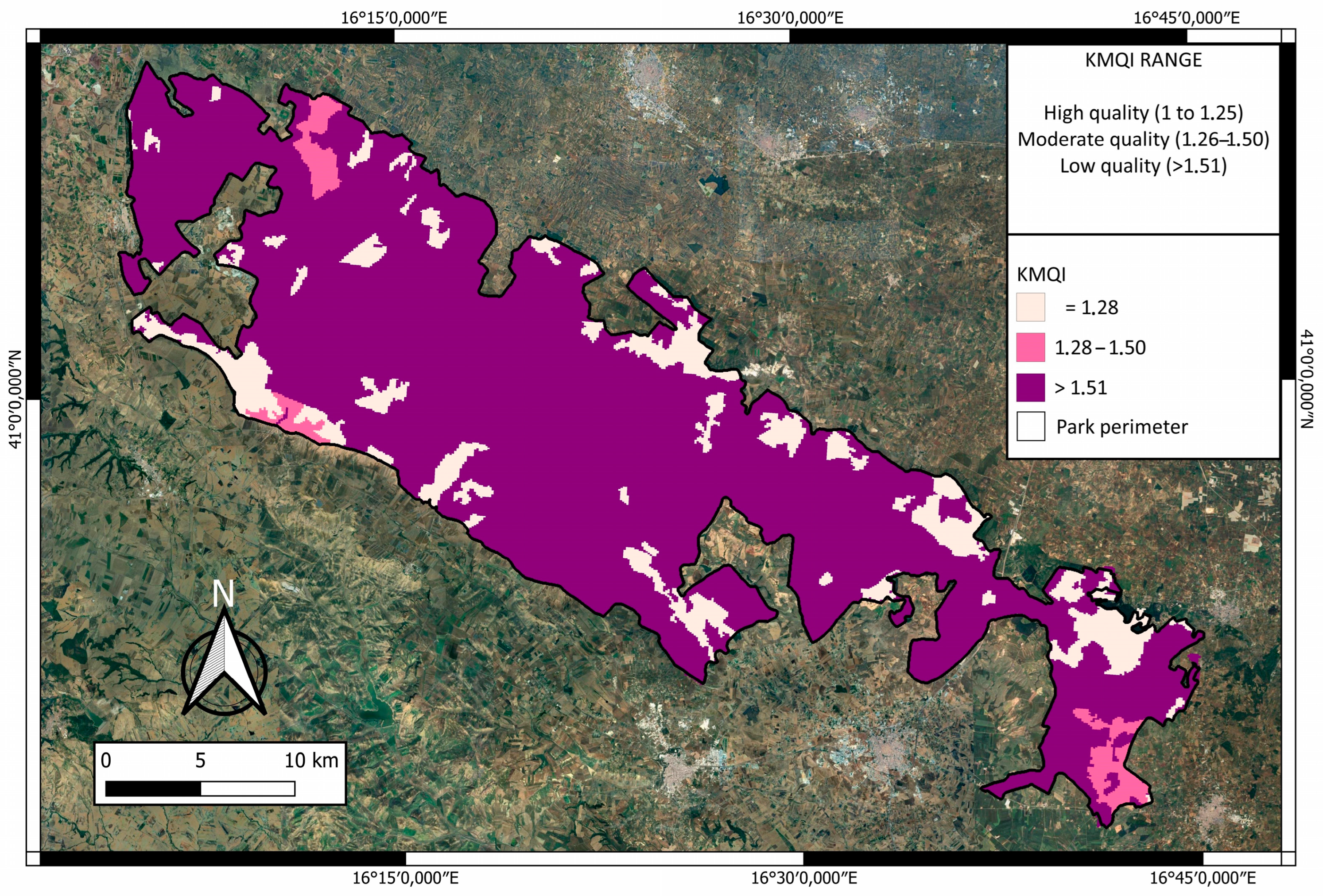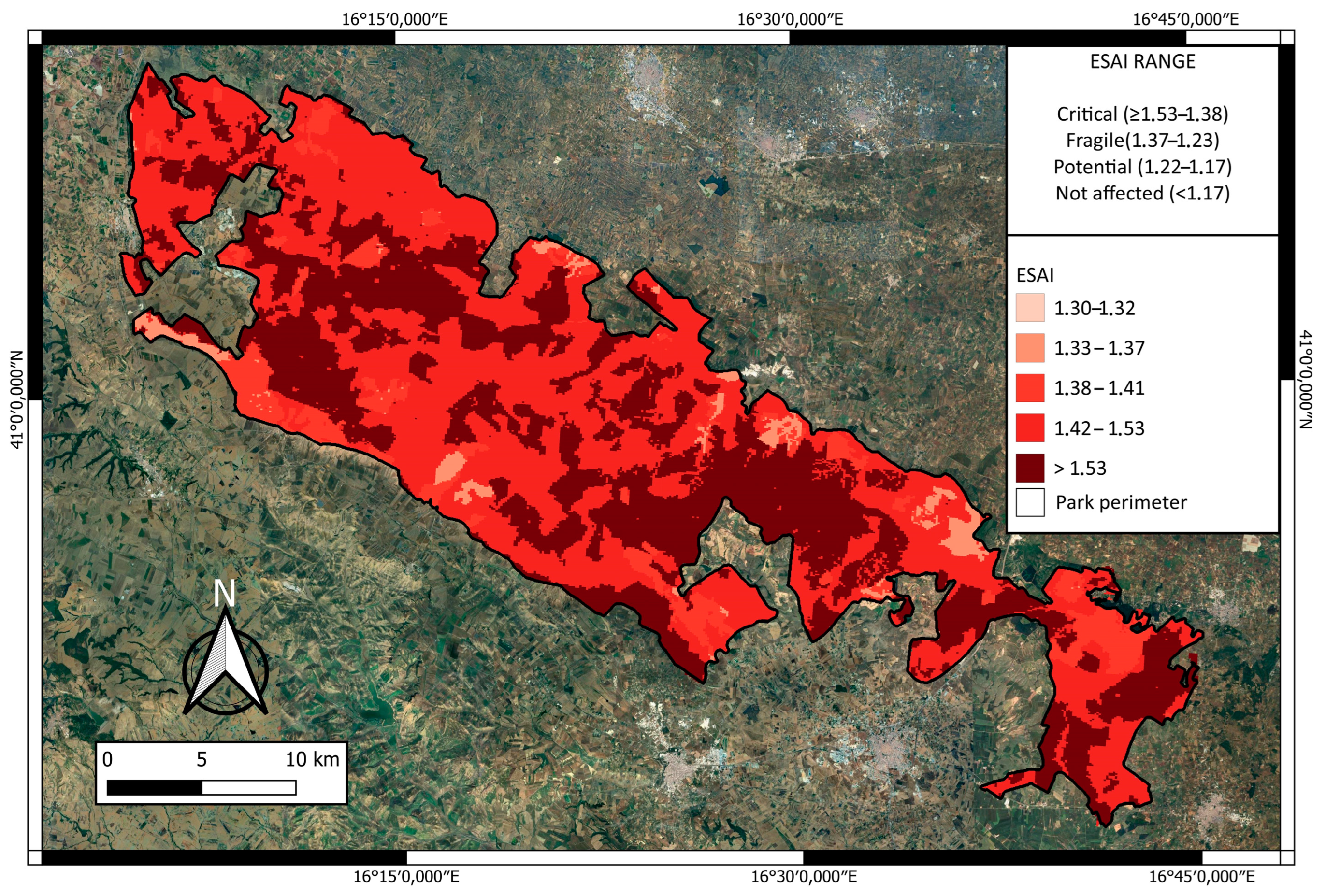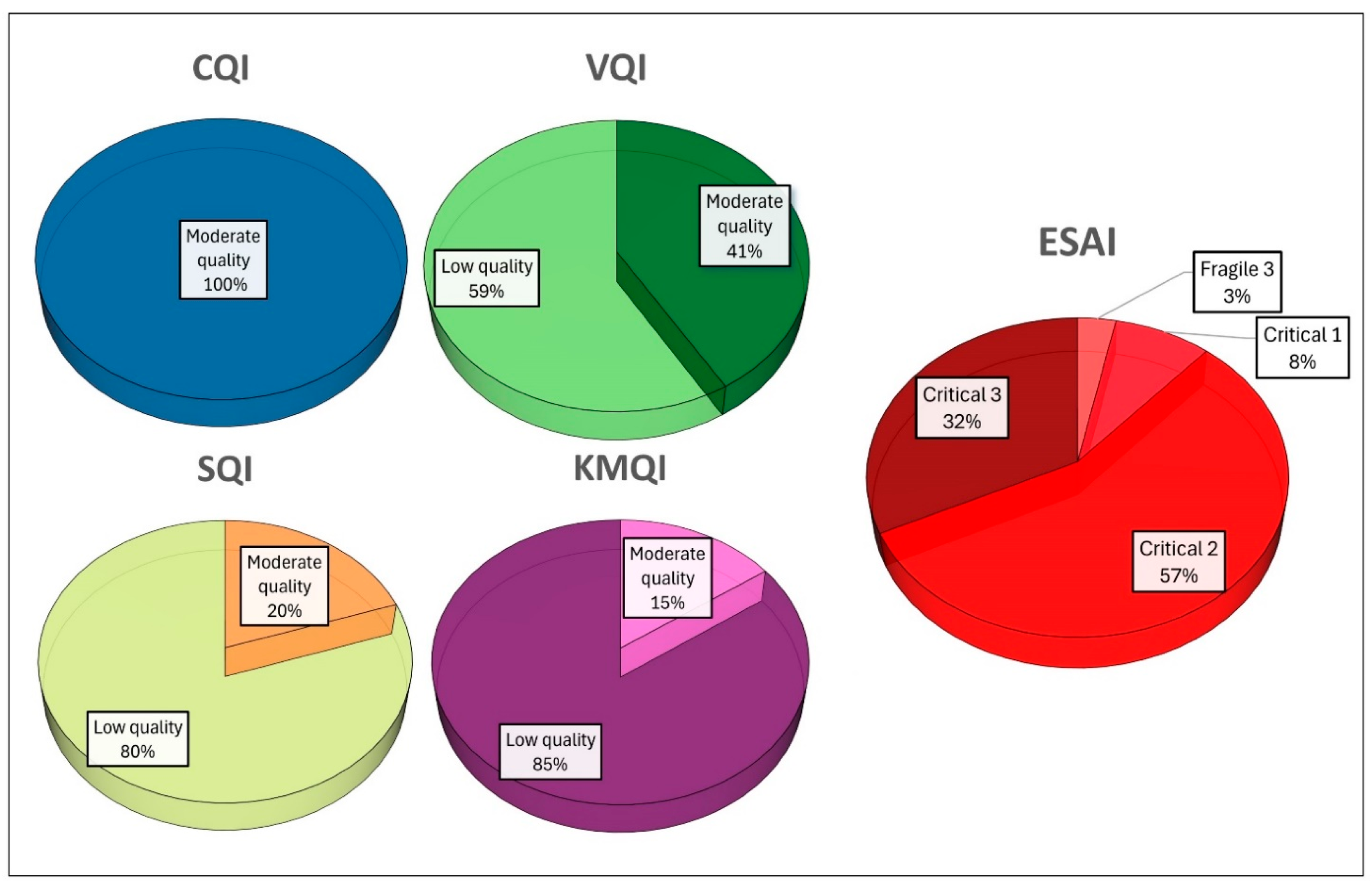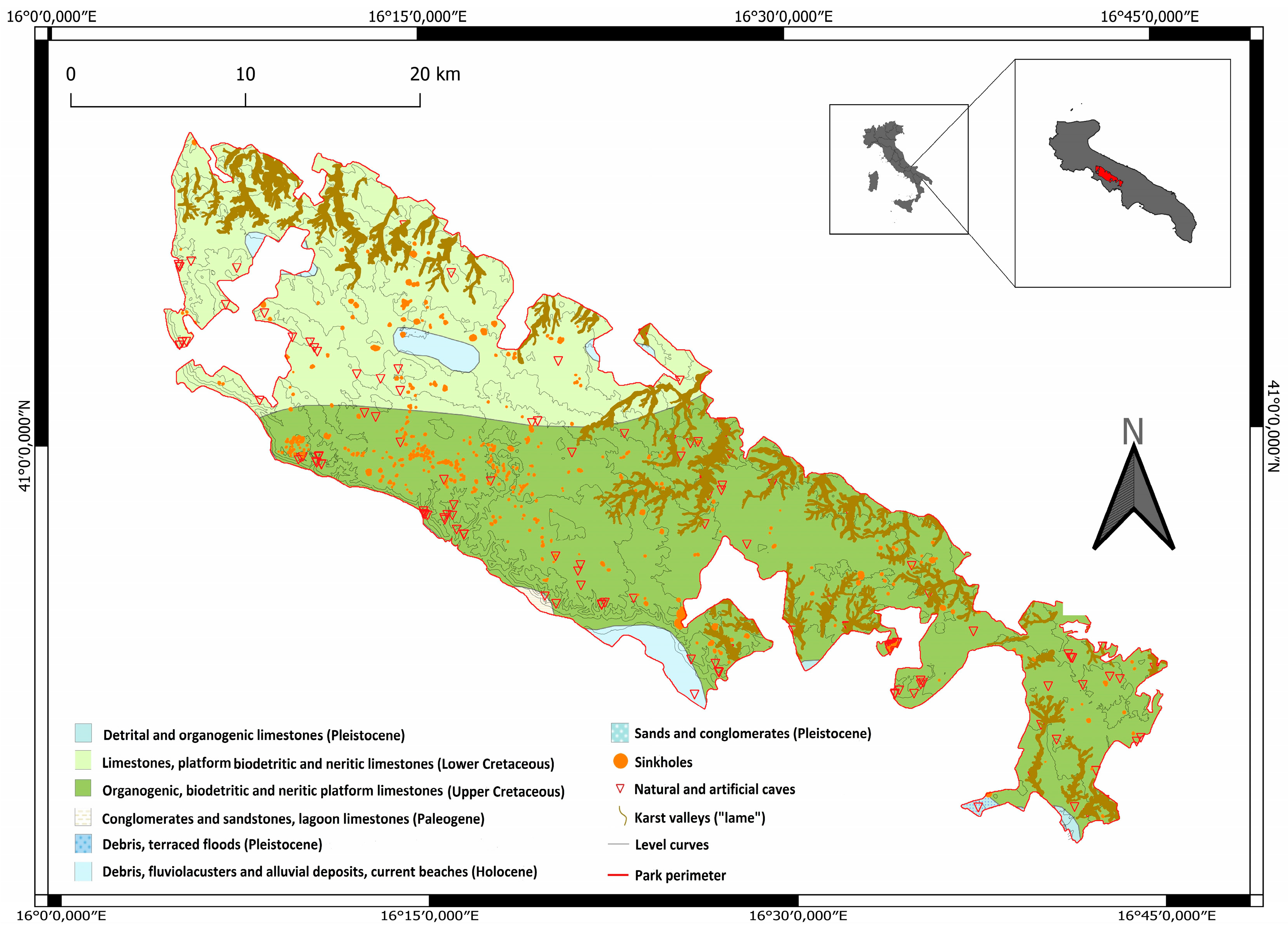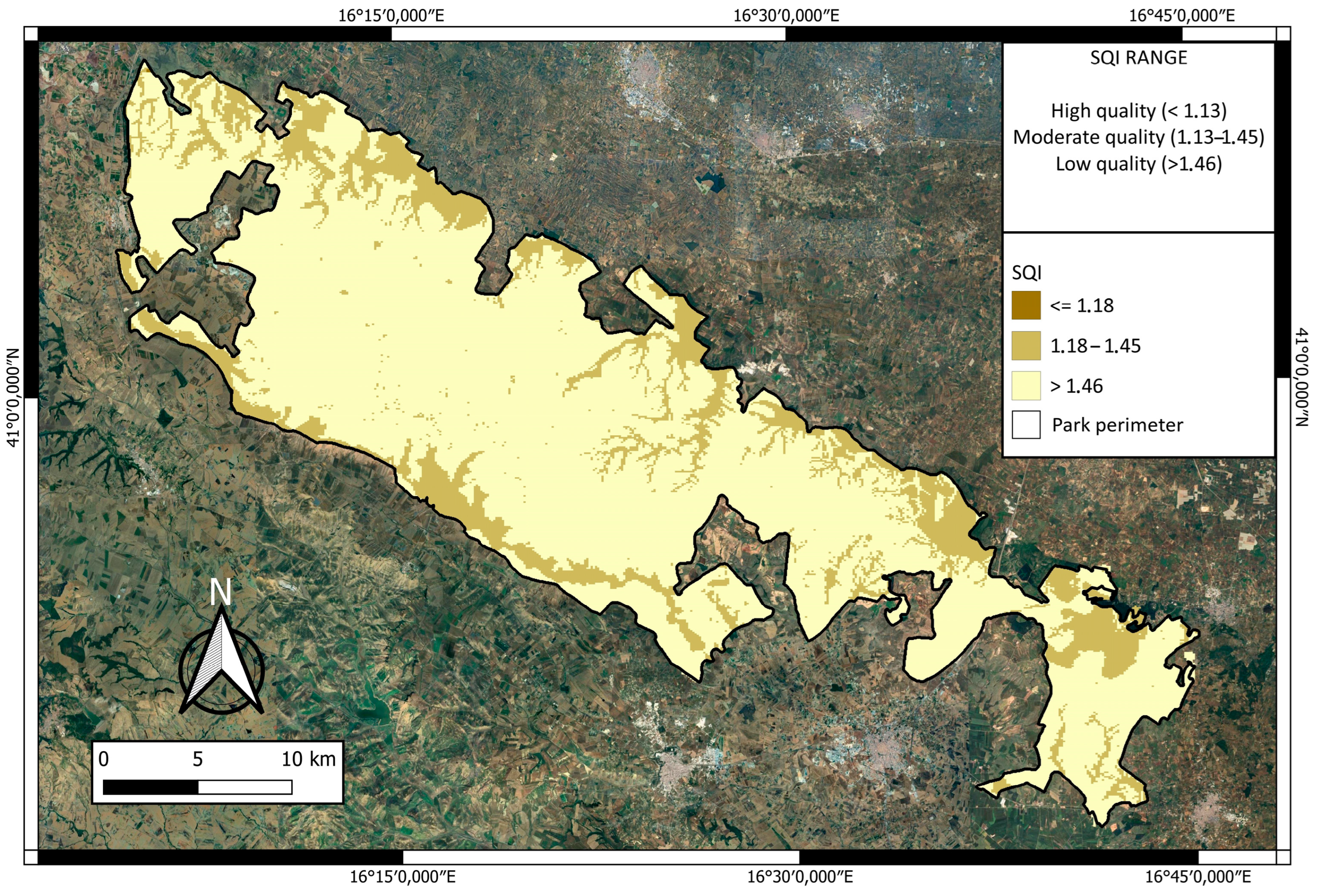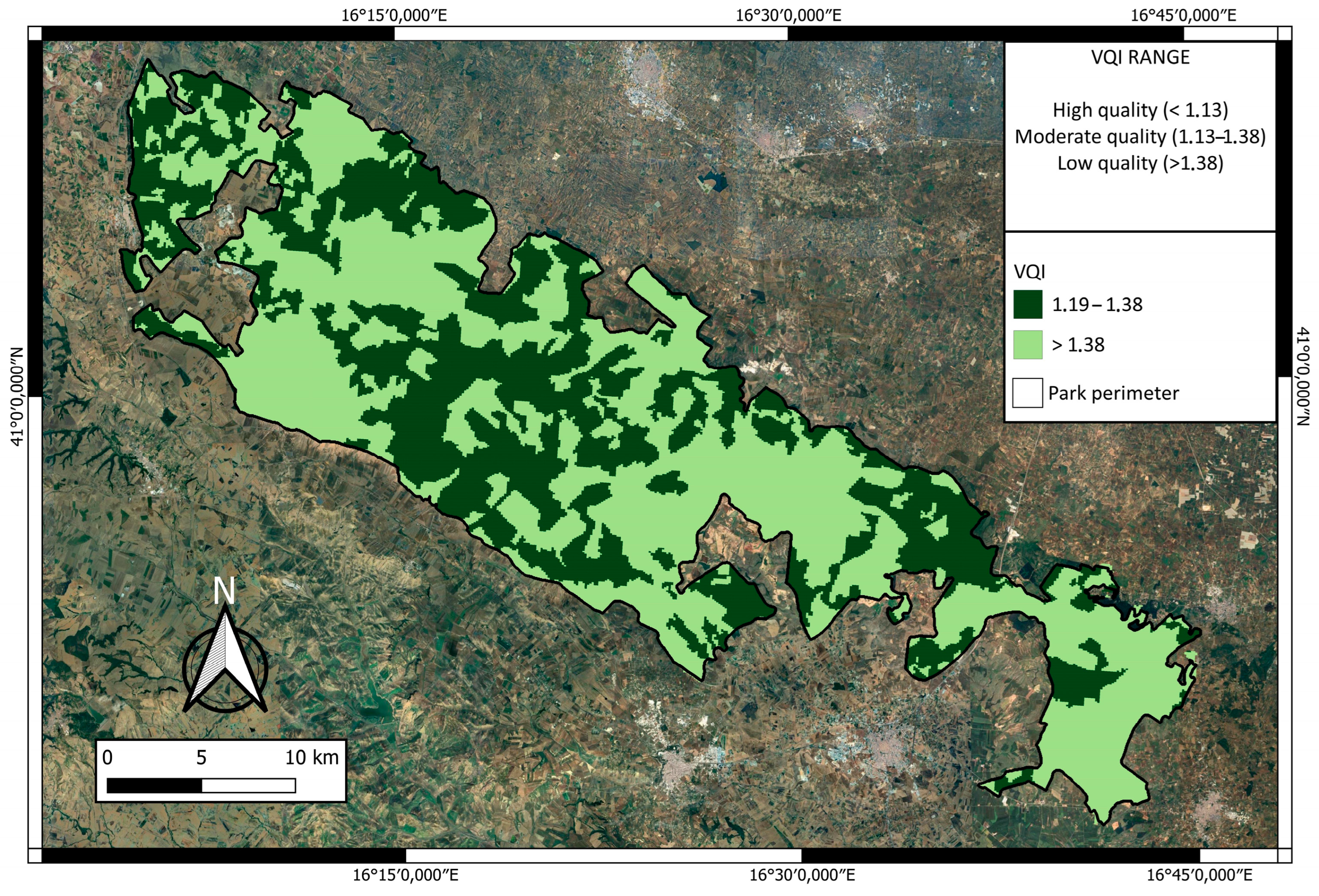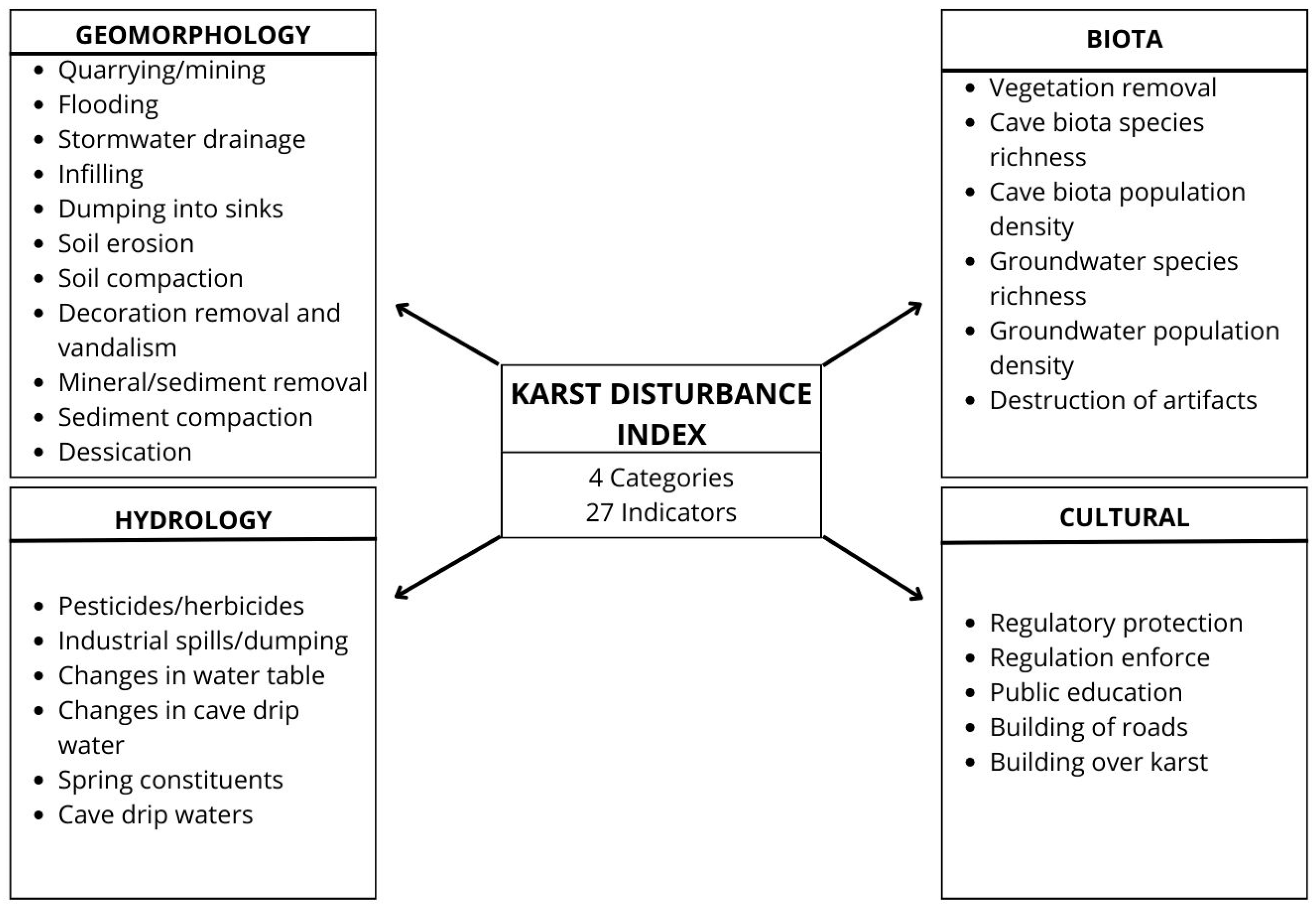1. Introduction
Desertification is one of the most critical environmental problems in the world in terms of ecosystems integrity, economic losses, and social issues. As defined by the 1994 United Nations Convention to Combat Desertification [
1], desertification is a form of land degradation in drylands resulting from various causes, including climatic variations and human activities. Therefore, desertification does not only mean the expansion of the classic concept of deserts (such as the Sahara or the Kalahari) because it is necessary to consider other environmental factors that could reach critical levels as a consequence of anthropogenic activities [
2]. Moreover, this phenomenon extends beyond drylands, which are particularly vulnerable to land degradation due to environmental factors such as low rainfall, low soil moisture, and poor soils, as well as anthropogenic factors such as a high human water resources demand [
3,
4,
5,
6,
7]. Statistics show that about a quarter of Earth’s land, corresponding to an area of over 3.6 billion hectares, is presently at risk of desertification, and around 250 million people are directly affected by this problem [
1,
8].
Mediterranean Desertification and Land Use (MEDALUS [
9]), is one of the most widely used methodologies to assess land desertification. It was initially developed for Mediterranean areas at the local, national, and regional scales [
10,
11,
12,
13]. However, due to the simplicity and flexibility of the model’s parameters, MEDALUS has been used in many other regions worldwide [
14,
15,
16,
17]. The original methodology is based on a comprehensive analysis of 15 variables, categorized into four main “qualities”: climate, soil, vegetation, and management, with the latter defined as “degree of human-induced stress” [
9]. In the first step of the model approach, the values for every variable were reclassified based on a variable/score classification system and introduced to a geographical information system (GIS). A generalized evaluation was then conducted to produce four quality indicators: Soil Quality Index (SQI), Vegetation Quality Index (VQI), Climate Quality Index (CQI), and Management Quality Index (MQI). These indicators were calculated as the geometric mean of the corresponding scores of the relevant variables. After the computation of the four indices for each quality, the environmentally sensitive areas (ESAs) to desertification were calculated by taking the geometric mean of the corresponding quality indicators.
The Alta Murgia plateau, in the Apulian karst (SE Italy), represents one of the most interesting environments of this region, being almost entirely characterized by soluble rocks at the outcrop [
18]. Apulia has the arid/semi-arid climate typical of the Mediterranean area, and is particularly susceptible to desertification due to unsuitable climatic conditions and negative human activities. In addition, karst is a very fragile environment, characterized by high physical anisotropy; such an environment, and to the resources stored therein (soil, water, cave systems, biota), could be damaged very easily, whilst restoration practices, when possible, are often highly time-consuming and expensive [
19,
20] and not entirely effective. The MEDALUS approach was applied in Apulia on many occasions, also using different parameters and indexes compared to the original model [
21,
22,
23,
24].
This study aims to map and assess the environmentally sensitive areas to desertification in the Alta Murgia karst plateau by using a modified MEDALUS GIS-based methodology. Unlike previous studies, the main modification applied to the model allows us to consider the peculiar features of the study area deriving from its karst geomorphology and hydrology. The aim of this work is also to assess the degree of disturbance in the karst environment, mainly resulting from a series of human activities that may exacerbate vulnerability to desertification within the study area. In fact, the original MEDALUS methodology offers limited information regarding the assessment of the human factor and its environmental impacts, providing only a broad, less detailed evaluation in the Management Quality Index instructions for calculation. This approach hinders the identification of potential anthropogenic causes and, consequently, the formulation of effective restoration and prevention strategies. Attempts have been made to resolve aspect through including the Karst Disturbance Index [
25,
26], which consists of many environmental indicators subdivided into the following five broad categories: geomorphology, hydrology, atmosphere, biota, and cultural. The calculation of the KDI allows for the modification of the Management Quality Index, facilitating the identification of a more detailed set of factors (both human and non-human) influencing the study area at a local scale.
2. Study Area and Database
The Alta Murgia karst plateau contains many different elements of historical, landscape, naturalistic, and scientific interest [
27,
28]. For this reason, it became a National Park in 2004, with an area of approximately 1250 km
2. At the beginning of 2019, the management of Alta Murgia National Park decided to make the territory a candidate to become a Geopark. In 2021, along with a large area of the Apulia region, the territory was announced as a new aUGGp (aspiring UNESCO Global Geopark) by the Italian National Commission of UNESCO [
29]; recently (9 September 2024), it became a UNESCO Geopark.
The climate of Alta Murgia plateau has a semi-arid regime, characterized by hot and dry summers and moderately cold and rainy winters; the rain tends toward the Mediterranean type, with a mean annual precipitation of about 550 mm/y [
30,
31]. The entire plateau shows typical aspects of karst geomorphology: the altitude ranges from sea level to 700 m a.s.l., with a widespread presence of underground voids, wide depressions (sinkholes, dolines, endorheic basins), shallow valleys with flat bottoms (locally named “lame”), and limestone outcrops [
18,
32,
33] (
Figure 1).
Before the 1970s, the most common activities in the plateau were related to pasture, with large uncultivated portions of land; there is evidence of a centuries-old balance between the environment and the pastoral agricultural system. Starting from the 1980s and leading up to the 1990s, an intensive transformation from pasture to arable land was registered due to a public program of financial support by the European Community. This land conversion occurred thanks to the use of heavy machinery for stone removal operations, which had a negative impact on the original karst landscape, particularly the epikarst [
37,
38]. In fact, as a result of this intense conversion of land cover, many karst landforms were highly disturbed and, in some cases, destroyed (this was, for instance, the case for many solution dolines [
39]). Moreover, surface erosion and loss of soil, even at low topographic gradients, often occurred during the most intense rainstorms [
40,
41].
In this study, the data used to map the environmentally sensitive areas to desertification include the digital elevation model (DEM), land use, soil data, and climatic data (rainfall and temperatures) (
Table 1). The DEM, with a spatial resolution of 8 m, acquired between 2006 and 2007, was extracted from the geodatabase of the Apulia region and used to retrieve the slope and aspect gradients [
42]. Land use data were acquired from the CORINE Land Cover 2018 map [
43], with a spatial resolution of 100 m, while soil data were obtained from an eco-pedological map of Italy [
44]. To acquire more accurate soil parameters, some geomorphological characteristics (presence of valleys and sinkholes) were taken into account through the use of vectorial files from the Apulian Regional Territorial Landscape Plan [
34]. Historical rainfall and temperature data, at monthly intervals, were extracted from the hydrological annals of Apulia, managed by the Regional Service of Civil Protection. They were collected for eight climate monitoring stations located in the study area.
Since the original data derive from several sources with different resolutions, the spatial scale was processed to obtain a consistent pixel size within the raster quality maps derived from GIS analyses.
5. Discussion
Based on the applied model, the study area exhibited an overall high potential for desertification. A general consideration is that the area is highly sensitive to desertification according to the results obtained from the ESAI. Depending directly on the SQI, CQI, VQI, and KMQI indices, the calculated ESAI shows critical values mostly because of the values related to the SQI, VQI, and KMQI indices. These show low-quality scores for more than 50% of the total area, demonstrating a direct relationship with the high percentage of land falling into the Critical sub-type in the ESAs.
Regarding the SQI, the results show that the soil in this area is mostly of a low-quality type, characterized by poor drainage and reduced soil thickness; thus, the Alta Murgia soil can be considered very vulnerable to erosion and unfavorable for vegetation growth. In other words, it is highly sensitive to desertification. Given the nature of the parent material, soil texture and depth could be considered the main factors in the reduction in soil quality, also considering the fact that the study area is a plateau, with slopes ranging from flat to gentle. However, this high percentage of degraded soil is mostly linked with anthropogenic activities. In particular, the stone-clearing and crushing practices do not favor good soil quality and enhance environment degradation, also worsening other indices, such as drainage and rock fragments. In the study area, low soil quality mainly characterizes the territories adapted to agricultural soils; those where the soil quality is moderate are mostly dolines/sinkholes and valleys (locally named “lame”), where soil depth becomes more substantial, reaching values greater than a few meters.
The CQI indicates a moderate quality class for the climate of the area, despite its semi-arid characters, with a moderate amount of rainfall, and thus this has less influence on the ESAI.
As the overall results show for the Soil Quality Index, the high percentage of low-quality vegetation in Alta Murgia can also be explained by its conversion to arable land. The VQI mostly categorizes the land into the low-quality type, with a lack of vegetation to reduce the desertification sensitivity resulting from fires, droughts, and erosion. Forests are basically absent, and most of the vegetation comes from agricultural activities related to cultivation and grazing.
Eventually, as regards the KDI, the implementation of this index to assess the Alta Murgia allowed for the identification of the most threatened components of the karst terrain. The high disturbance score characterizes indicators of
quarrying,
soil erosion,
soil compaction,
decoration removal/vandalism,
mineral/sediment removal,
sediment compaction,
industrial spills/dumping,
vegetation removal, and
regulation enforcement, with most of them belonging to the category of
Geomorphology. Quarrying activities are widespread in the Alta Murgia karst plateau, especially in the north-eastern territories (Minervino Murge municipality), which has a high quarry density. Quarries with a remarkable extension (up to 1.3 km
2) can also be found in other municipalities, such as Andria or Altamura. Some abandoned quarries are often used as a dump for pollutants from industrial or commercial activities, as is unfortunately quite common in other karst areas of Apulia [
81,
82]. Generally, quarries change the appearance of the karst landscape, influencing other indices such as
soil erosion,
soil compaction,
industrial spills/dumping, and
vegetation removal, to which a high KDI value was assigned. The indicators
soil erosion and
soil compaction received the highest value, mainly due to the stone clearing and crushing activities, which involved a considerable portion of Alta Murgia. These activities also had a negative impact on the indicator
vegetation removal; the conversion of extended grassland to arable land severely damaged the typical vegetation, which was originally characterized by significant biological diversity. In addition, deforestation activities have been practiced over millennia for felling and grazing, as evidenced by the presence of remnants of deciduous forests. For these reasons, the maximum disturbance score was assigned to the indicator
vegetation removal. Regarding underground karst features, the whole study area contains a significant amount of cave systems [
60,
83] that also includes remarkable sites such as the Lamalunga Cave, where a Neanderthal skeleton was found in 1990 [
84]. Many caves in the territory are easily accessible even by non-expert cavers, and this often results in low protection of these sites and their important deposits. This greatly influenced the score attributed to the indicators
decoration removal/vandalism,
mineral/sediment removal, and
sediment compaction, which received the highest value. Many of the problems related to the previously discussed indicators are still unsolved, even following the Alta Murgia’s membership in the UNESCO geopark circuit. For these reasons, some negative scores were assigned to the indicators belonging to the category
Cultural, such as
regulation enforcement (score of 3) and
regulatory protection (score of 2).
The KMQI considers the KDI sub-indexes (quarrying, stone clearing and crushing activities, spills and dumping, lack of regulation enforcement, etc.) and demonstrates that the studied karst environment is highly vulnerable to human disturbance. The low-quality score obtained using the KMQI is also justified by the widespread use of land for agricultural purposes and from the excessive livestock density, which often leads to overgrazing phenomena causing both a reduction in the availability of forage and an increase in soil erosion and ecological damage. In particular, the sub-indicator “intensity of land cultivation” has significant values (2.00); most of the study area (84.87% according to CLC data) belongs to the Utilized Agricultural Area [
24] class, indicating low management quality values (>1.51) and a higher degradation risk due to the intensification of agricultural practices, and in increase in the use of mechanization, fertilizers, pesticides, etc. the KMQI also shows a low quality score for pasturelands because of the very high livestock density (>100 heads per square km), with an overall average of 282 sheep heads for 1 km
2 [
85]. The values for the sub-indicators “land use intensity in forest” and “urban/industrial infrastructure density” are low (1.00), mainly due to the absence or near-absence of forests or urban and industrial infrastructure, which positively affects the final KMQI value. The sub-indicator regarding mining areas has a high value (2.00) because of the high density of quarries in the study area and the poor measures for controlling erosion. Lastly, the sub-indicator concerning land use shows a moderate value (1.33) as a result of the possibility convertible areas for grazing or crops.
6. Conclusions
In this study, the desertification risk of the Alta Murgia karst plateau was assessed through a combination of the MEDALUS model and a GIS-based approach. The MEDALUS procedure was adjusted to develop a local model that takes into account the karst nature of the study area. The aim of this research was to assess the degree of disturbance caused by both the effects of climate changes and the negative anthropogenic activities carried out over the years in this type of fragile environment. Four composite quality indexes, each comprising several sub-indicators, were analyzed; these were soil, climate, vegetation, and karst management. Then, such indices were combined and processed in the GIS environment to develop a raster map of environmentally sensitive areas to desertification. According to the obtained results, the key findings of this study can be summarized as follows:
The Critical land category accounts for 97% of the study area, as indicated by the desertification risk map;
The predominance of the Critical class is primarily attributed to human activities, which introduce additional threats (related especially to the SQI, VQI, and KMQI) to areas already naturally prone to desertification;
The evaluation of KDI sub-index used for calculating KMQI (originally named MQI) provided deeper insights into the key human-induced disturbances affecting desertification risk in the Alta Murgia karst plateau;
The results obtained could be slightly overestimated for all the calculated indices, as indicated in the map, where no area with “high quality” is present;
Some of the parameters that were needed to calculate the different indices do not take into account the complex and case-specific environmental conditions.
Nevertheless, this study demonstrated that the MEDALUS approach is conceptually very simple and easy to implement as a GIS-based method even at a local scale, although there is still a need to collect more input information that might be available in the georeferenced format. The approach has a high level of flexibility and offers wide-ranging opportunities to update existing indices. Finally, this study could be a good starting point to obtain more in-depth knowledge on desertification in karst territories and highlight priorities for land protection and preservation. The maps resulting from the combined procedure, which are presented and explained throughout the manuscript, can also be used by local managing authorities for the definition and adoption of strategic actions to mitigate desertification in these vulnerable areas around the world.
